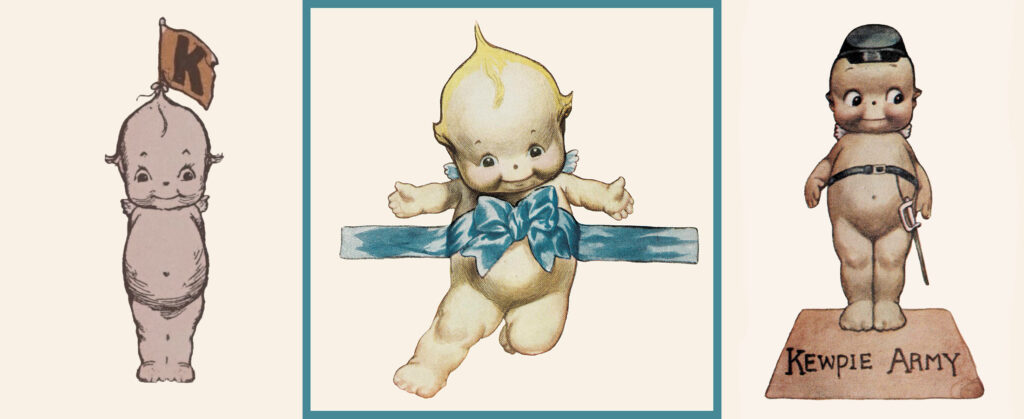Rose O’Neill Wilson of Day, Missouri registered a copyright on June 8, 1909 for two illustrated sheets 9 ½ by 12 ½ inches entitled “Kewpies, their Life and Exploits.” This registration is viewable in the publication called “Catalogue of Copyright Entries” for Pamphlets.
Kewpies in Books by Rose O’Neill
In 1910 Rose O’Neill wrote and illustrate a children’s book entitled “The Kewpies and Dotty Daring” published by Crowell Publishing Company and then later in 1913 by George H. Doran Company of New York. One can easily view and turn the pages of the 1913 version of the book online at the Archive site or view it at the Library of Congress.
Kewpie Kutouts – Woman’s Home Companion
Kewpie Kutouts first appeared for readers of the Woman’s Home Companion magazine in September of 1910. The first page entitled Dotty Darling and the Kewpies – verses and pictures by Rose O’Neill appeared on pages 20-21. The Hathitrust digitized public domain copy sadly omits these from the 1910 magazine. The magazine advertised the feature by saying, “The most wonderful tribe of little folks has been discovered by Rose O’Neill and will delight COMPANION boys and girls for months to come.”
That same year the Christmas issue featured Kewpie gift ideas from Kewpie decorated telephone index cards and bookmarks to candles and desk calendars.

Kewpie Dolls
Joseph Kallus, of Brooklyn, sculpted the first Kewpie dolls at age 17. The George Borgfeldt & Co., an exporter of European made dolls and toys, used its connections to have the dolls produced in German factories.
The Kewpie Doll Patent
On February 12, 1912 Rose O’Neil Wilson’s patent for a Kewpie doll registered as #46,680 serial 737,311 as shown in the 1913 edition of the Pottery & Glass Salesman publication which featured the doll in an article on page 31 of the April 17 issue. The patent registered for a 14 year term. The doll was controlled at first soley by Geoge Borgfeldt & Co. of Irving Place and 16th St. New York.
In the July issue of the 1913 Pottery & Glass Salesman a sitting Kewpie patent drawing is shown with his hands under his chin (769,091)
In 1927 Rose O’Neill Wilson and Callista O’Neill Schuler registered a patent that did not publish until 1930 for a stuffed rag or cloth doll kewpie (US 1785800 A) which Callista improved upon in 1932 (US 1875355 A).
Kewpie Dolls Advertised
In June of 1913 the department store Woodward & Lothrop advertised Kewpie dolls, in infant size wearing short dress and booties. The ad claims these infant size dolls are as adorable as the originals. The sold for $1 each.
German Manufacturing
Various Germany companies manufactured Kewpie dolls and figurines before WWI. The Kestner jointed composition doll with the bisque head holds great value among many collectors. Alt, Beck, & Gottschack possibly produced a cloth body doll with a bisque head with the mold number 1377.
Early German made all bisque Kewpies may have the incised word “Germany” on the back, a red paper label heart, O’Neill incised on the bottom of the foot, or (if not all) a round paper label on the back that reads Design Patented.

Kewpies’ Behavior Described
The Evening Star featured an ad in 1915 saying “the wise Kewpies are always are always doing the right thing to make little and big folks comfortable, contented, and happy.”
Kewpies Copyright Lawsuit
The French publication Le Droit d’Auteur (copyright) published an article about the lawsuit Rose O’Neill filed against William Hecht who registered the trademark “Kewpie.” O’Neill lost the lawsuit on the grounds that just because she used the word “Kewpie” to give title to her writings and illustrations that she had not automatically gained rights to sole use of the word itself. The writer said, “Thus the thesis that the owner of a subject matter on which copyright exists thereby also acquires a property on the designation or name of this object is declared erroneous.”
Rose O’Neill – the Kewpie Lady
The Day Book out of Chicago called Rose Cecil O’Neill the “Kewpie Lady” in the April 24, 1915 edition providing a photo of Rose’s smiling face.
The University Missourian called her a “real Bohemian – mysterious, fascinating, and charming” living in Bonnie Brook (the name of the O’Neill home) of Shepherd Hills in southeast Missouri. Artist, illustrator, and novelist, O’Neill was born in Pennsylvania and the family moved west to Missouri as homesteaders. The oldest of seven children, Rose attended the Art Institute of Chicago at age 16
Kewpies in the washing Herald
In 1917 the Washington Herald ran a Kewpie ad that claimed Rose O’Neill received the highest payment among women artist in the world and that she only worked for one Newspaper, the Herald! The ad described the Kewpie as the most fascinating and popular art and humor conception every produced by an artist.
The Herald announced the Kewpies would appear in the paper every Sunday in a series called “Doings of the Kewpies.”
One could find other newspapers featuring the Kewpies. The Richmond Virginian carried a full page in 1918 entitled “The Kewpies and their Fairy Cousins” by Rose O’Neill.
Current Trademark Ownership
The KEWPIE CORPORATION in Japan holds presentday ownership of the word “KEWPIE” as a trademark for doll manufacturing (serial 73698255). They claim its first use was in December of 1912. The Kewpie Corporation listed address is at 4-13 Shibuya, 1-Chome, Shibuya-ku, Tokyo JAPAN 150002.
See other antique German doll manufacturer marks here.
